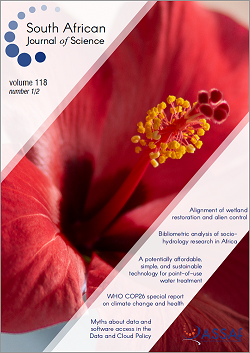Phytochemicals and in silico investigations of Sudanese roselle
DOI:
https://doi.org/10.17159/sajs.2022/10383Keywords:
roselle, polyphenols, anthocyanins, gout, xanthine oxidaseAbstract
We analysed four different Sudanese roselle samples for their potential as novel xanthine oxidase (XO) inhibitors. Phytochemical screening showed the presence of polyphenols, flavonoids, organic acids, saponins and sterols in all samples. Liquid chromatography with tandem mass spectrometry (LC-MS/ MS) was used to identify and characterise five anthocyanins in all samples: cyanidin-3-glucoside (cy-3-glu), delphinidin-3-sambubioside (dp-3-sam), cyanidin-3-rhamnoside (cy-3-rhm), delphinidin-3‑rhamnoside (dp-3-rhm) and pelargonidin-3-glucoside (pg-3-glu). Identification of cy-3-rhm, dp-3-rhm and pg-3-glu confirmed the selectivity and sensitivity of LC-MS as a powerful technique for identifying anthocyanins. In silico studies of the identified anthocyanins were performed to explore their promising inhibitory activity toward XO. Interactions between the ligand and the enzyme were via the H-bond, and hydrophobic (π-alkyl, π-sigma and alkyl) and/or electrostatic (π-cation) bonds. Inhibition of the anthocyanins was compared with that of topiroxostat, a commercial drug for hyperuricaemia. Dp-3-rhm was the most active inhibitor with a binding energy of ca. -10.90 kcal/mol compared to topiroxostat’s binding energy of ca. -8.60 kcal/mol. The good inhibition results obtained from anthocyanins toward XO suggest their application as a drug candidate to treat gout and other diseases related to the activity of XO.
Significance:
- Sudanese roselle is rich in phytochemicals, particularly polyphenols and anthocyanins. The isolated anthocyanins in this study were explored as novel potential XO inhibitors. Further pharmacological and clinical studies are necessary for the development of new potential anthocyanin drugs to treat gout and other diseases related to XO increased activity such as hypertension.
Published
Issue
Section
License

All articles are published under a Creative Commons Attribution 4.0 International Licence
Copyright is retained by the authors. Readers are welcome to reproduce, share and adapt the content without permission provided the source is attributed.
Disclaimer: The publisher and editors accept no responsibility for statements made by the authors
How to Cite
- Abstract 653
- PDF 953
- EPUB 517
- XML 602












.png)